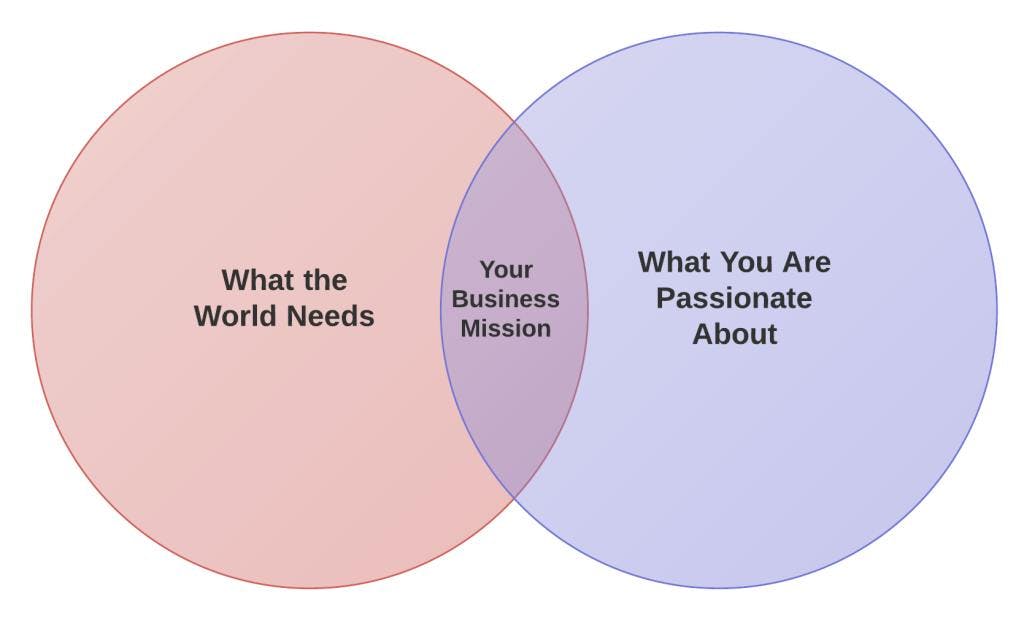Looking for your life purpose? Start by identifying and solving big problems
oo many people are putting their lives into building something they just aren’t that passionate about. If you want to make an impact, find the intersection of need and passion, and don’t be afraid to pursue the “big idea.”
This article was written by the original owner of startupguide.com, Ryan Allis, and published on his website in 2012. Read more about why Ryan was happy to hand over his website domain to us here.
Various scholars - from Max Marmer to C.Z. Nnaemeka - have lamented the lack of startups striving to solve the big problems. If you’re going to go through the hell of building a startup, you might as well come out the other side having built something that made a difference in the world and solved a big problem. Of course, you can start hacking at solving a big problem by solving little problems, but it’s important to always keep the end goal in mind.
“The happiest and most successful people I know don’t just love what they do, they’re obsessed with solving an important problem, something that matters to them,” Dropbox co-founder Drew Houston said in his 2013 MIT Commencement address. “They remind me of a dog chasing a tennis ball: their eyes go a little crazy, the leash snaps and they go bounding off, plowing through whatever gets in the way.”
Fortunately, it’s actually a lot easier to work intensely on solving a problem you are really passionate about than on one you are not. Taking the time to figure out what problems in the world you are passionate about solving is the key. Life is just too short to build things that don’t make the world better.
Thomas Edison once explained his approach to innovation succinctly: “I find out what the world needs. Then, I go ahead and invent it.”
The most successful businesses tend to be born out of that sweet spot where what the world needs intersects with what you are deeply passionate about. If you don’t know what your personal mission is - what change you want to create in the world - start with what you’re passionate about.

The "sweet spot" where the world's needs intersect with what one's passionate about.
Big problems, big opportunities
If you want to build a really big business you have to solve a really big problem. Luckily, there are hundreds of emerging areas that contain both big problems and big opportunities. Some of them are already pressing issues, while others are just appearing on the horizon. These issues need courageous and inspired business leaders to build scalable solutions that can impact billions of people.
A few areas that contain big opportunities over the next twenty years include: clean energy, battery storage, clean water access, graphene desalination, global healthcare, telemedicine, cloud education and government, AI, robotics, quantum computing, synthetic biology, NUI software, clean transportation, anti-corruption tracking, cybersecurity, and private space exploration.
Of course there are many more than just these. Challenge yourself to think bigger and challenge yourself to build a company that solves major human problems. That’s how you become a billionaire while making a major impact.
Find programs that will introduce you to these topic areas, like the the Singularity University Executive Program in Mountain View, California. Watch informational videos, like this future of science and technology course from Jeffrey Grossman. Personally, these two courses greatly increased my understanding of how companies are commercializing science and solving major human problems.
Build a business that aligns with your life purpose
Before you begin a new business or find a new problem to solve, take the time to write down your life purpose. Think about the change you seek to create in the world, and then start a company to make that change real.
Ask yourself three simple questions: What are the big problems I see in the world? Which one am I most passionate about solving? How can I create a business that solves that problem, creates value some people are willing to pay for, and makes the world better?
Don’t make the mistake of building a company if you’re not deeply passionate about the problem you are trying to solve. Too many startups try to solve problems they’re not passionate about solving, and then burn out because they don’t have the source of inspiration and energy to carry them through the tough times.
Knowing that your business mission is aligned with your personal life mission can help immeasurably to keep you on course and give you the resilience to weather the storms that are sure to come. Once you know who you want to become, you can direct your life rather than letting outside factors control you.
My life purpose is to build and invest in companies that use technology and design to solve major human challenges. Finding this core motivation at age 18 has been critical to getting me through the difficult and challenging times. It’s helped me to find the strength from within to persevere in the face of seemingly insurmountable odds.
In line with my life mission, I’m now building a company called Connect to make it easier for people to communicate with each other around the world. We hope to become the leader in social mapping, but we know we have a lot of hard work ahead.
Start small, but stay aligned
Finally, if the scale of the problems out there intimidates you, start smaller. Pick a small problem that you feel ready to tackle—but don’t forget your overriding motivation and mission.
If you can start with a small problem that is aligned with your greater mission, it can act as a confidence-builder and a stepping stone to the bigger problems you care about solving. Let who you are and what you believe in come out in all that you create.
You’re trading your life in order to bring what your startup builds to the world. What you build is truly your gift to the world. Make your gift awesome.
Main photo: Startup Stock/ Estratton Bailey & Weare Sculpt
*This article was originally published on October 17th, 2018 and updated on December 11th, 2018.

